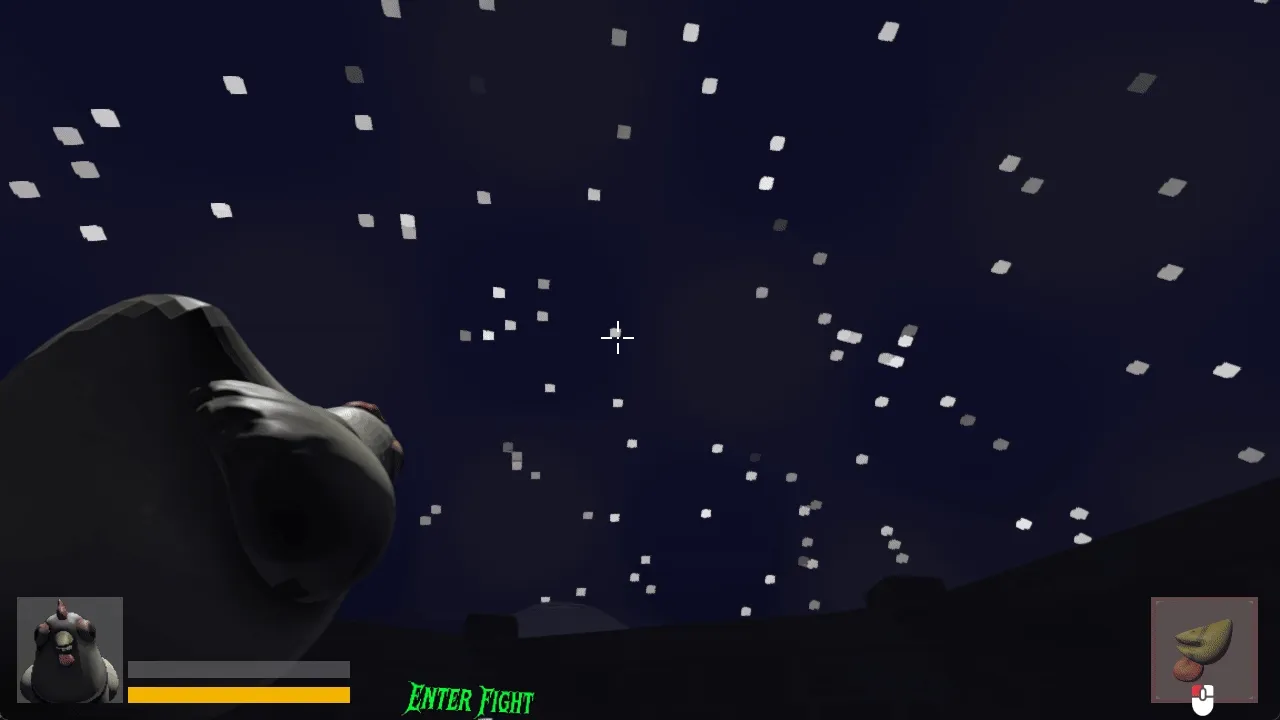Night Sky Shader

The sky box, visible from the arena and intermission area, uses a sky shader to create a night sky with animated stars and drifting clouds. It is based on the Godot Sky Shader tutorial
- Sky Gradient: Blends between two colors from horizon (where the sky meets the ground) to zenith (the point directly overhead).
- Stars: Procedurally generated twinkling stars with adjustable density, brightness, and scale.
- Clouds: Animated, semi-transparent clouds using a noise texture, moving slowly across the sky.
- Performance: Clouds are rendered at half resolution for efficiency, then composited over the sky.
Shader Code
Section titled “Shader Code”shader_type sky;render_mode use_half_res_pass;
// Night sky colorsuniform vec3 sky_color_a : source_color = vec3(0.01, 0.01, 0.05); // Dark blue/black near horizonuniform vec3 sky_color_b : source_color = vec3(0.05, 0.05, 0.15); // Slightly lighter dark blue zenith// Darker clouds for nightuniform vec3 cloud_color : source_color = vec3(0.1, 0.1, 0.15);uniform float cloud_min = 0.3;uniform float cloud_max = 0.8;uniform float cloud_speed = 0.01;uniform sampler2D cloud_noise;
// Star parametersuniform float star_density : hint_range(0.9, 0.999) = 0.98;uniform float star_brightness : hint_range(0.5, 2.0) = 1.0;uniform float twinkle_speed : hint_range(0.0, 5.0) = 2.0;uniform float star_scale : hint_range(10.0, 200.0) = 80.0;
// Pseudo-random number generatorfloat hash(vec2 p) { p = fract(p * vec2(123.34, 456.21)); p += dot(p, p + 45.32); return fract(p.x * p.y);}
// Function to generate starsvec3 generate_stars(vec3 eyedir) { // Normalize eyedir to treat it as a direction on a sphere vec3 dir = normalize(eyedir); // Use a projection to map direction to a 2D plane for hashing // Adjust scale factor to change apparent star density/size vec2 uv = dir.xz / (dir.y + 1.0) * star_scale;
// Use floor to create grid cells, hash the cell coordinate float star_noise = hash(floor(uv));
// Threshold for star existence (higher value = fewer stars) float stars = smoothstep(star_density, star_density + 0.005, star_noise);
if (stars > 0.0) { // Add twinkling effect based on time and star position float twinkle = 0.6 + 0.4 * sin(TIME * twinkle_speed + star_noise * 100.0); // Add variation in base brightness using another hash float brightness_variation = hash(floor(uv) + vec2(0.1, 0.2)); // Combine effects and apply overall brightness uniform return vec3(1.0) * stars * twinkle * (0.5 + 0.5 * brightness_variation) * star_brightness; } else { return vec3(0.0); }}
// Modified sky gradient function including starsvec3 generate_sky(vec3 eyedir) { // Create gradient float horizon = smoothstep(-0.1, 0.5, eyedir.y); vec3 base_sky = mix( sky_color_a, sky_color_b, horizon );
// Generate stars vec3 stars = generate_stars(eyedir);
// Add stars to the base sky color return base_sky + stars;}
// Generate clouds based on noise texture (using darker color)vec4 generate_clouds(vec3 eyedir) { // Create UV coordinates based on eyedir, dividing to get a curved effect vec2 uv = eyedir.xz / (eyedir.y + 1.0);
// time-based movement uv.y -= TIME * cloud_speed;
uv = fract(uv); // Combat the tiling effect
// Sample noise texture float noise = texture(cloud_noise, uv).r;
// generate clouds float clouds = smoothstep(cloud_min, cloud_max, noise);
// Use the darker cloud_color and keep semi-transparency return vec4(cloud_color, clouds * 0.7);}
void sky() { // Render clouds at half resolution for performance if (AT_HALF_RES_PASS) { vec4 color = generate_clouds(EYEDIR); COLOR = color.rgb; ALPHA = color.a; } // Render the base sky (now with stars) and composite the half-resolution clouds on top else { vec3 color = generate_sky(EYEDIR); COLOR = mix(color, HALF_RES_COLOR.rgb, HALF_RES_COLOR.a); ALPHA = 1.0; }}Shader Parameters
Section titled “Shader Parameters”sky_color_a,sky_color_b: Colors for the horizon and zenith.cloud_color: Color of the clouds.cloud_min,cloud_max: Thresholds for cloud density from the noise texture.cloud_speed: Speed at which clouds move across the sky.cloud_noise: Noise texture used to generate cloud shapes.star_density: Controls how many stars appear in the sky.star_brightness: Controls the overall brightness of the stars.twinkle_speed: Speed of the star twinkling animation.star_scale: Controls the size and spacing of stars.
Shader Logic
Section titled “Shader Logic”- Sky Gradient:
- Blends between two colors based on the vertical direction, creating a transition from horizon to zenith.
- Stars:
- Uses a hash function to procedurally generate star positions and brightness.
- Stars twinkle over time and have slight brightness variation for realism.
- Clouds:
- Uses a noise texture to create soft, semi-transparent clouds.
- Clouds drift slowly by animating the UV coordinates over time.
- Rendered at half resolution for performance, then composited over the sky.